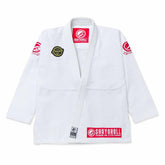Is Gi or No-Gi BJJ Better for Real-World Self-Defense?
When it comes to Brazilian Jiu Jitsu (BJJ), one of the most common questions beginners and seasoned practitioners ask is: Is Gi or No-Gi BJJ better for real-world self-defense? The debate has been ongoing for years. But when it comes to your safety on the streets, it is important to understand the strengths and limitations of both styles. In this article, we will dive deep into the topic. Hence, helping you decide which path is more effective for real-life self-defense situations.
Understanding the Basics: Gi vs. No-Gi BJJ
Before we jump into the self-defense aspect, let us quickly differentiate between Gi and No-Gi BJJ:
- Gi BJJ is practiced wearing a traditional BJJ Gi — a heavy cotton jacket and pants, similar to what you see in Judo. The Gi provides grips. Thus, allowing for techniques like collar chokes, sleeve controls and lapel submissions.
- No-Gi BJJ, on the other hand, is practiced wearing tight-fitting clothing like bjj rash guards and bjj shorts. Since there is no Gi to grab, the focus shifts towards speed, body control, underhooks, overhooks, and joint locks. Thus, it does not rely on clothing.
Both formats build powerful grappling skills. But when considering real-world self-defense, key factors like environment, clothing and speed play a huge role.
Gi BJJ for Self-Defense: The Pros and Cons
Advantages of Gi BJJ for Self-Defense
a- Control Through Clothing
In real-world situations, people are usually wearing clothes—jackets, hoodies, t-shirts, jeans. Gi BJJ prepares you to grab onto whatever your attacker is wearing, just like you grab a BJJ Gi during training. Techniques like collar chokes and sleeve grips translate perfectly into a street fight. In such fights, grabbing clothing can help control or neutralize a threat.
b- Precision and Technicality
Training with the Gi forces you to be more precise. You learn how to set up submissions methodically. You learn using small, technical adjustments that can make a huge difference when adrenaline is high and reactions are unpredictable.
c- Grip Strength Development
Gi BJJ builds incredible grip strength. This strength can be crucial in self-defense scenarios, where holding onto an attacker could mean the difference between escape and being overpowered.
Disadvantages of Gi BJJ for Self-Defense
a- Over-Reliance on Grips
If an attacker is shirtless or wearing minimal clothing, many Gi-based techniques become less effective. And this is very common in street fights during hot seasons or in nightclubs. Training that relies heavily on jacket grips may not always apply.
b- Slower Pace Gi
BJJ often involves a slower, more methodical pace. In real-world fights, speed and explosiveness often matter more than slow setups.
No-Gi BJJ for Self-Defense: The Pros and Cons
Advantages of No-Gi BJJ for Self-Defense
a- Realistic Movement and Reactions
No-Gi BJJ closely mirrors the slippery, fast-paced dynamics of a real-world encounter. Without the luxury of grabbing clothing, you learn to rely on body position, balance and explosive control. These skills are invaluable in self-defense situations.
b- Focus on Submissions and Escapes
Since you cannot rely on a BJJ Gi, No-Gi BJJ emphasizes clinch work, takedowns, arm locks, and chokeholds that do not depend on attire. You get used to reacting quickly and finding submissions or escape routes without needing special grips.
c- Adaptability in Any Situation
No matter what the attacker is wearing (or not wearing), No-Gi techniques are universally applicable. Whether it is controlling someone’s wrist, securing a choke or escaping a bad position, your skills remain useful.
Disadvantages of No-Gi BJJ for Self-Defense
a- Harder to Control Aggressors
Without clothing to grip, it can be harder to control a wild, aggressive opponent. In some cases, slipping grips or losing positions becomes a real problem.
b- Less Emphasis on Positional Dominance
No-Gi BJJ sometimes focuses more on fast scrambles. It does not focus on maintaining dominant positions like mount or side control. These positions are critical when trying to control an attacker safely until help arrives.
Gi vs No-Gi BJJ: Which is Better for Self-Defense?
When it comes to pure self-defense, both Gi and No-Gi BJJ offer critical skills that could save your life. However, if we must lean towards one being more "universally" applicable:
- No-Gi BJJ might have a slight advantage because it does not rely on an opponent wearing specific clothing. Its emphasis on movement. Real-world grips and submission skills can be effective whether you are on the beach, at a party or on the streets.
- Gi BJJ, on the other hand, offers valuable lessons in control, grip fighting and patience. Moreover, in colder climates or urban settings where people usually wear heavier clothing, Gi-based techniques can be incredibly effective.
Why the Best Answer Might Be: Train Both
For real-world self-defense, the smartest move is to train both Gi and No-Gi BJJ. Developing skills in both areas gives you a complete toolkit:
- You learn how to use clothing to your advantage (thanks to BJJ Gi training).
- You become fast, adaptable and effective even when grips are not an option (thanks to No-Gi BJJ training).
The best Brazilian Jiu Jitsu practitioners for self-defense scenarios are those who are versatile, comfortable grabbing clothing when available and just as lethal when it is not.
Conclusion: Master BJJ, Stay Safe
At the end of the day, it does not matter whether you train in Gi BJJ or No-Gi BJJ. The most important thing is to consistently practice, build real grappling experience and train for realistic scenarios. Brazilian Jiu Jitsu provides one of the most effective frameworks for self-defense. It is so because it teaches you how to stay calm under pressure, control bigger opponents and use technique over brute strength.
If your goal is real-world readiness. Then you should combine the technical precision of Gi training with the dynamic intensity of No-Gi BJJ. By doing so, you will become a well-rounded martial artist capable of handling any situation life throws your way.
Final Tip:
When choosing a gym, look for one that offers both Gi and No-Gi BJJ classes. Train hard, stay consistent, and remember — the best self-defense is being prepared for any situation, no matter what your opponent is wearing.



















